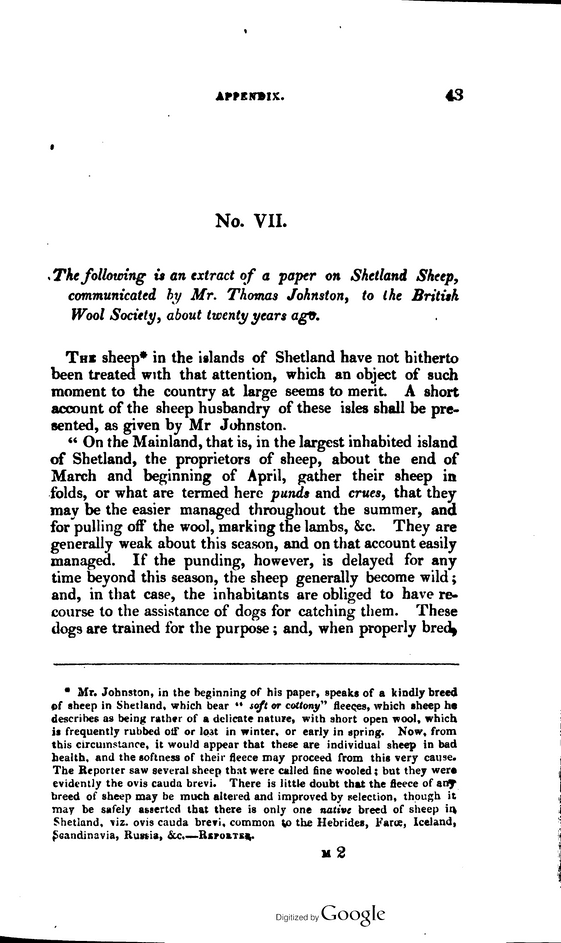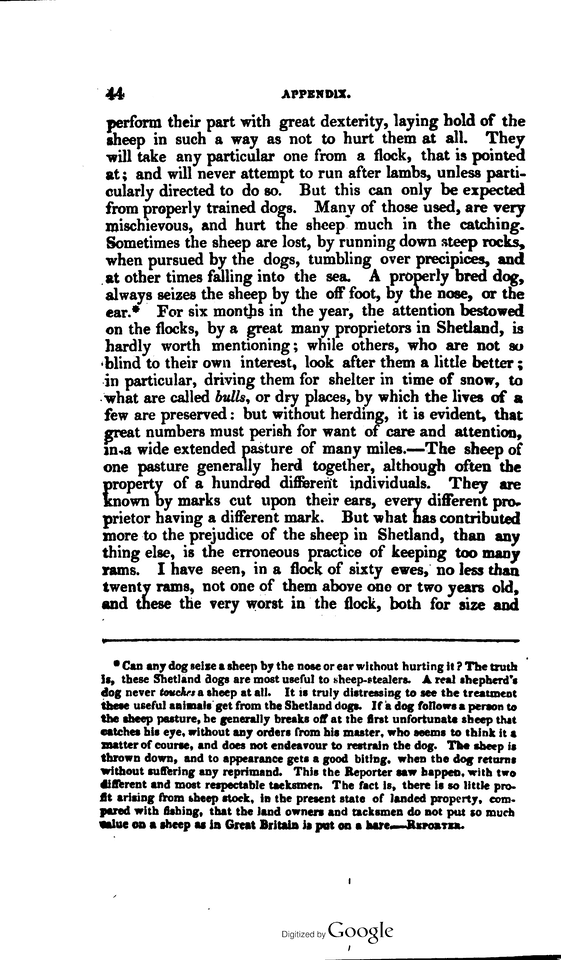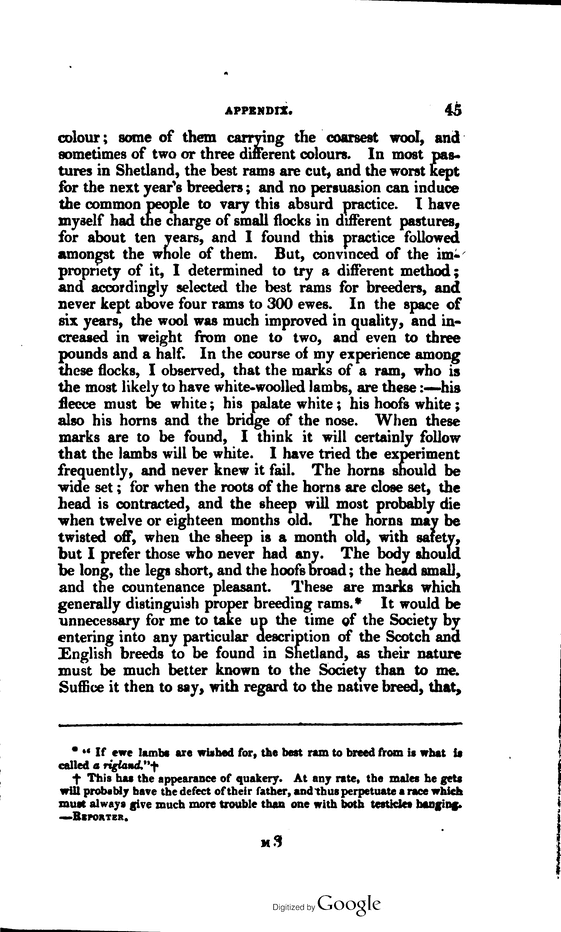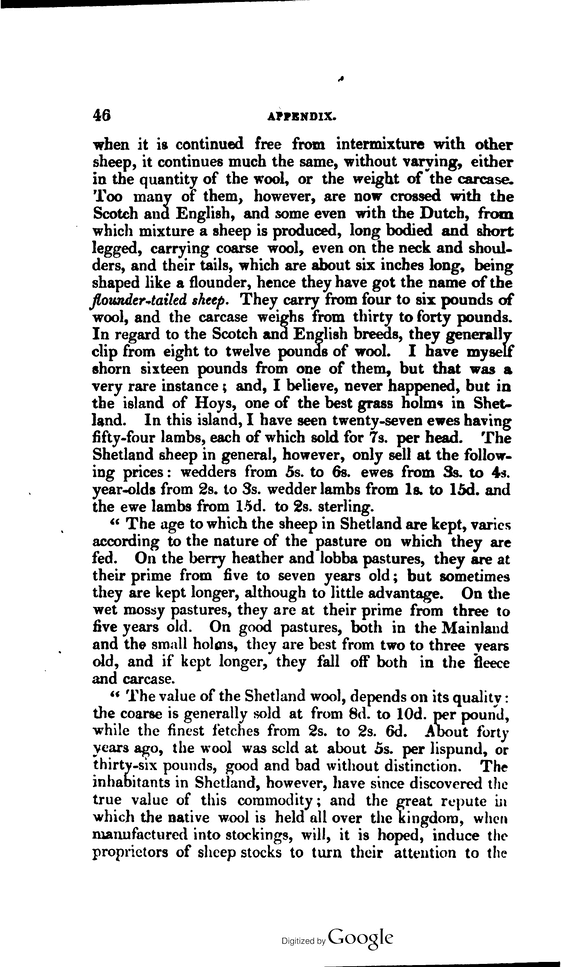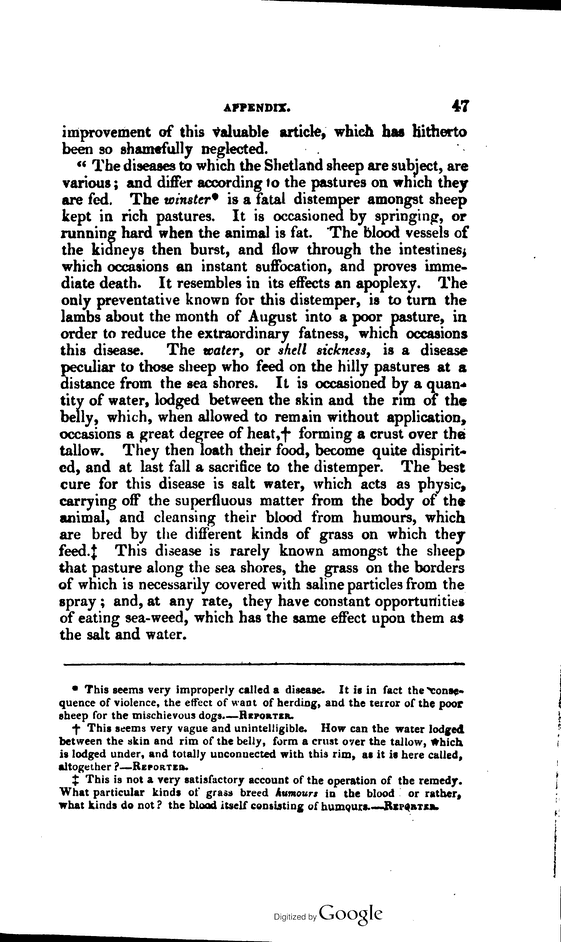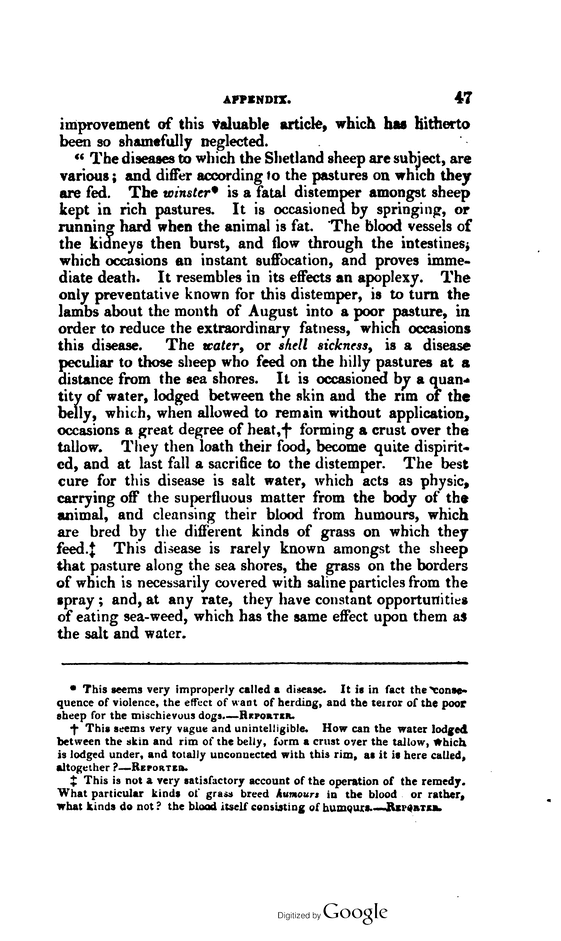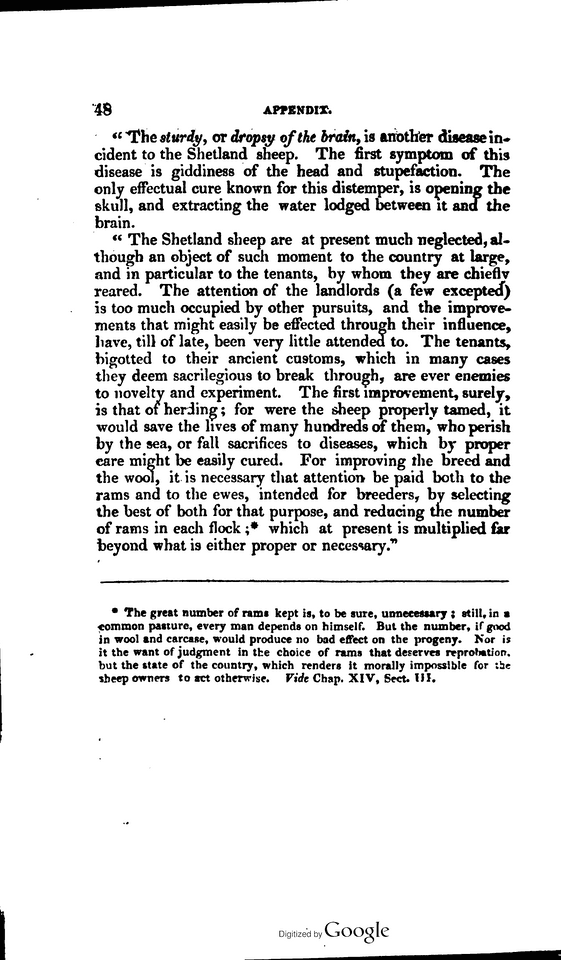Bull
Source : Wright, Joseph English Dialect Dictionary
web : https://eddonline4-proj.uibk.ac.at/edd/main.html
BULL, sb.1 Var. dial. uses in Sc. Irel. and Eng.
1. In phr. (1) the black bull of Noroway, an imaginary
monster; (2) the black bull's trodden on him, he is in a bad
temper; (3) as fell as a bull, angry, savage; (4) to get the
bull down, in Sheffield: to finish extra work before
Christmas; (5) the bull's head, a signal of condemnation
and execution; obs.; (6) to play with the bull, to run needless
risks, to be foolhardy.
(1) Ags. A child is kept quiet by telling it the Black Bull of
Noroway shall take it, Blackw. Mag. (Feb. 1817) 117 (Jam.).
(2, 3) n.Lin.1 (4) w.Yks. Has tha getten t'bull dahn, Jack? Senior
Smithy Rhymes (1882) 59; w.Yks.2 s.v. Bull-week (q.v.). (5) Sc.
If the bull's ill-omen'd head Appear to grace the feast, Scott
Minstrelsy (1802) II. 399 (Jam.). (6) n.Lin.1 You'll plaay wi' th'
bull while you get a horn in yer ee.
2. Comb. (1) Bull-badgering, bull-baiting; (2) Bull-baiting,
a disturbance among neighbours; (3) Bull-box, a small barn
in which a bull is kept; (4) Bull-chain, a chain attached to a
car in a coal-mine; cf. jackcatch; a chain in a cow-stall;
(5) Bull-coppie, the yard or croft in which a bull is kept; (6)
Bull-dance, a merrymaking at cattle-show feasts; (7) Bull-faces,
tufts of coarse grass; a laid mass of growing wheat; (8)
Bull-grips, iron clasps for leading a bull by the nose; (9)
Bull-hassocks, raised tufts of grass; (10) Bull-hided, unable to
sweat; (11) Bull-hole, a deep hole in a ‘beck’; (12) Bull-jumpings,
the first milk given after calving, ‘beestings,’ q.v.;
a custard made of ‘beestings’; (13) Bull-'s liver, a hard
peaty substance found below the surface of marshy soil;
see below; (14) Bull-lugged, strong, thick; esp. of leather;
(15) Bull-men, rearers of bulls; (16) Bull-'s noon, midnight; (17)
Bull-nosed, flattened; (18) Bull-pated, of grass: beaten down by
wind or rain; (19) Bull-ring, see below; (20) Bull-scurrying,
rough horseplay; (21) Bull-scutter, liquid excrementum of a
bull after gorging with new grass; fig. anything worthless
and nasty; (22) Bull-seg, a bull castrated when full grown;
(23) Bull-sowerlugs, a sullen fellow; (24) Bull-squitter, a fuss
about a trifle; (25) Bull-stag, (26) Bull-stub, see Bull-seg; (27)
Bull-week, the week before Christmas, in Sheffield; see
below; (28) Bull-wheel, to case a wet hole with clay for shot
firing; (29) Bull-wolloper, a cattle-dealer; (30) Bull-young-uns,
the rubbish in a deserted bird's-nest.
(1) n.Yks.2 (2) Der.2, nw.Der.1 (3) Oxf.1 MS. add. (4)
w.Yks. (J.H.B.), Shr.2 (5) Cum. (J.Ar.) (6) n.Yks.1 n.Yks.2 (7)
Nhb.1 Called also bull-fronts, buff-fronts, bull-snouts, and winnel-strae.
Cum.1, n.Yks.2, ne.Yks.1, Chs.1 s.Chs.1 Dhŭr)z ŭ men·i
bùl·-fai·siz i dhaat· wéeŭt. (8) Cum. Ye'll want the bull-grips to
keep him quiet, Caine Shad. Crime (1885) 33; Cum.1, Chs.1
(9) n.Lin.1 (10) w.Yks.2 (11) n.Lin.1 (12) Cum.1, Wm. (B.K.),
n.Yks. (W.H.) w.Yks. Willan List Wds. (1811). n.Lan.1,
ne.Lan.1 (13) s.Chs.1 Stf.2 ‘Bull's liver and sawdust’ is a
meaningless term used in answering an awkward or impertinent
question. (14) e.Yks.1 (15) Lin. Fashionable breeders and bull-men,
Marshall Review (1811) III. 177. (16) Lan. Stood gawpin
at um till bull-noon, Scholes Tim Gamwattle (1857) 58. e.An.1,
Nrf.1, Cmb.1 Ess. No bull's-noon hours I'll ha ya keep, Clark
J. Noakes (1839) 17; Gl. (1851); Ess.1 (17) Der. The nuts most
prized for the game of ‘cob-nut’ were ‘bull-nosed cobberers’ or
‘cob-nuts,’ or ‘bulleys,’ N. & Q. (1890) 7th S. ix. 138-9. (18) Nhp.1
(19) Cum. He wad shek the bull-ring, and brag the heale town,
Anderson Ballads (1805) 59; Cum.1 To ‘shak t'bull-ring’ was to
challenge the village, &c., to produce a champion to fight the
‘shakker.’ (20) Lan. There's olez a lot o' slotchin' an' bullscurryin'
afther one o' thoose doments, Clegg David's Loom (1894) xv. (21)
Lan. O' beggar-berm an' bull-scutter, Waugh Chimn. Corner (ed.
1879) 56; Lan.1, e.Lan.1 (22) Sc. Roaring like bull segs, Scott
Monastery (1820) iv. n.Cy. Grose (1790); N.Cy.1, Nhb.1, n.Yks.1 n.Yks.2,
ne.Yks.1 e.Yks. Makinge a bull segge of a bull that is two or three
years old, Best Farming Bk. (1642) 141-2. m.Yks.1 w.Yks.
Hutton Tour to Caves (1781). n.Lin.1, Der.2, War. (J.R.W.)
(23) n.Yks.2 (24) se.Wor.1 (25) War.3, Glo.1 Glo.2 Hrt. Ellis Mod.
Husb. (1750) V. i. Wil.1 Almost obs. Dor.1, w.Som.1 (26) Shr.1
(27) w.Yks. What sooat an a bull week had ta? Bywater
Sheffield Dial. (1839) 22; When the work is over the men say
they have ‘gotten t'bull by t'tail,’ Sheff. Leader (Mar. 1874);
w.Yks.2 The cutler works harder than usual during this week.
At the end of the last century a master told his workmen that if
they got their work done before Christmas they should have
a bull cut up amongst them; w.Yks.4 (28) w.Yks. (S.K.C.)
(29) Dev. Reports Provinc. (1895). (30) s.Chs.1 Eyŭr)z ŭ neyst fùl
ŭ bùl-yùngg·ŭnz.
3. Comb. in plant-names: (1) Bulls-and-cows, Arum maculatum,
cuckoo-pint; (2) Bulls-and-wheys, (a) Arum maculatum;
(b) Aconitum napellus, monk's-hood; (3) Bulls-bags,
any tuberous orchid; (4) Bull-bine, Clematis vitalba, wild
clematis; (5) Bulls' brows, patches of rough tangled grass,
esp. Aira caespitosa; (6) Bull buttercup, Caltha palustris,
marsh marigold; (7) Bull daisy, Chrysanthemum leucanthemum,
ox-eye daisy; (8) Bull flower, see Bull buttercup; (9)
Bull's foot, Tussilago farfara, colt's-foot; (10) Bull's forehead,
(11) Bull-front, see Bulls' brows; (12) Bull-grass, Bromus mollis;
(13) Bull-haws, the double-stoned fruit of hawthorn; (14)
Bull-jumpling, Trollius europaeus, globe flower; (15) Bull-pates,
(16) Bull-peats, (17) Bull-poll, see Bulls' brows; (18) Bull-rattle, (a)
Lychnis vespertina, white campion; (b) Silene inflata,
bladder campion; (19) Bull-seg, (a) see Bull-bags; (b) Typha latifolia,
bulrush; (20) Bull-slop, Primula variabilis, large
hybrid oxlip; (21) Bull-thistle, Carduus lanceolatus; see
Boar-thistle; (22) Bull-toppin, see Bulls' brows; (23) Bull-tree,
Sambucus nigra, elder; see Bour-tree; (24) Bull-tussock,
see Bulls' brows.
(1) N.Cy.1 Nhb.1 Also called Lam-lakens. e.Yks.1, w.Yks.1,
ne.Lan.1, n.Lin.1 Nhp.1 Also called Bobbin and Joan. War.1
(2, a) Wm., n.Yks. (b) n.Wm. Also called Priest's Pillys (B.K.).
(3) Ags. People attribute a talismanic and aphrodisiacal virtue to
the root (Jam.). (4) Hrt., Hmp. (5) Som. (W.F.R.) (6) Ess.
(7) Cum., n.Yks., Chs.1, e.An. (8) Dev.4 (9) s.Bck. (10) n.Cy.
Grose (1790) Suppl. e.Yks. Marshall Rur. Econ. (1788).
Som. (W.F.R.) (11) Cum.1, w.Yks.1 (12) Rxb. Science Gossip
(1876) 39. Nhb.1 Called also Goose grass. (13) N.Cy.1, Nhb.1,
n.Yks.2 (14) n.Yks. (15) Shr.1, Hrf. (W.W.S.), Glo. (A.B.)
(16) Nhb.1, s.Wor.1, Glo.1 (17) Glo.1 Wil. Bull polls, on which
snakes often coil in the sunshine, Jefferies Gt. Estate (1880) ii;
Wil.1 (18, a) Bck. (b) Bck., I.W. (19) Sc. (Jam.) (20) Chs.1 (21)
n.Ir. Dor. (G.E.D.) w.Som.1 Bèol-duy·shl ─ daash·l. (22) Cum.1,
Der.2, nw.Der.1 (23) Cum. (24) Der.2, nw.Der.1
4. Comb. in names of animals, &c.: (1) Bull-bird, Aegialitis hiaticula,
ringed plover; (2) Bull-of-the-bog, Botaurus stellaris,
bittern; (3) Bull-fit, Cypselus apus, swift; (4) Bull-french,
a bullfinch; (5) Bull-frog, an imaginary monster; (6) Bull-huss,
Scyllium catulus, large spotted dog-fish; (7) Bull-joan, (a)
a small fish with a large head, prob. Cottus gobio; (b)
a tadpole; (8) Bull-jub, (9) Bull-knob, Cottus gobio; see Bull-head;
(10) Bull mackerel, Scomber scombrus; (11) Bull-olph, see Bull-french;
(12) Bull-rout, Gobius minutus, goby; (13) Bull-spink, (a) Fringilla coelebs,
chaffinch; (b) bullfinch; (14) Bull-stang, a dragon-fly;
a gadfly; (15) Bull-stanger, a horse-fly; (16) Bull-tang, a dragonfly;
(17) Bull-thrush, Turdus viscivorus, missel thrush; see
Bothresh; (18) Bull-ting, see Bull-tang; (19) Bull-trout, a large
variety of salmon trout.
(1) I.W.2 (2) Sc. The deep cry of the bog-blitter, or bull-of-the-bog,
Scott Guy M. (1815) i. Rxb. Swainson Birds (1885) 146.
(3) Dmf. (Jam.) (4) Lnk. (JAM.) (5) n.Dev. Believed to live under
the foundation stones of old houses, &c., N. & Q. (1850) 1st S. ii.
512. (6) Ken.1 Sus. N. & Q. (1879) 5th S. xii. 193. (7, a) w.Yks.
Leeds Merc. Suppl. (Jan. 9, 1892). e.Lan.1 (b) Lan. Th' raisin-puddin'
'at owd Mall made, wi' bull-jones in it, Waugh Besom Ben
(1865) i; Lan.1, e.Lan.1 (8) [Satchell (1879).] (9) Shr.2 (10)
[Satchell (1879).] (11) Nrf. Science Gossip (1882) 283; (G.E.D.)
(12) Ken.1 (13, a) n.Cy. Grose (1790) Suppl. n.Yks.1 n.Yks.2 n.Yks.3, ne.Yks.1
e.Yks. Marshall Rur. Econ. (1788); e.Yks.1, m.Yks.1, w.Yks.2,
ne.Lan.1 (b) w.Yks.2 w.Yks.3, e.Lan.1 (14) N.Cy.1 Cum. Grose (1790);
Gl. (1851); Cum.1 Wm. That mare will run away if she hear
a bull-stang buzzing about (B.K.); Wm.1 n.Yks.1 Called also
Flying-ether and Stang; n.Yks.2, ne.Yks.1, m.Yks.1, ne.Lan.1
(15) Cum. (M.A.R.) (16) m.Yks.1 (17) Hmp. Wise New Forest
(1883) 189; Hmp.1 (18) w.Yks. Leeds Merc. Suppl. (Jan. 9, 1892).
(19) N.Cy.1 Tarras for the good bull-trout, Old Rhyme. Nhb.1
5. A steam whistle used in factories, &c. War., Wor.
(J.W.P.) Oxf.1 MS. add.
6. A large marble. N.I.1
7. A round bar of iron, used in blasting wet stone.
Nhb.1 Nhb., Dur. This process consists in filling a drill hole in
wet stone with strong clay, and then driving a round iron rod,
nearly the size of the hole, to its far end, previous to putting in
the gunpowder, Greenwell Coal Tr. Gl. (1849). w.Yks.1
8. A prop to prevent a set of ‘tubs’ from falling down
a mine-shaft.
Nhb.1 Also called ‘a cow.’ The recoil of the load causes the
horns of the cow, or bull, to be thrust into the ground, whilst the
bull holds the weight.
---
BULL, sb.2 Sc. Nhb. Yks. Lan. Lin. Shr. [bul.] The
bar or beam of a harrow. Cf. bowle, sb., bun, sb.5
Or.I. (Jam.) Nhb.1 Disting. from the lighter crossbars, or sheth.
n.Yks. (I.W.); n.Yks.1 ne.Yks.1 In common use. m.Yks.1,
ne.Lan.1 n.Lin.1 Also called Buns. Shr.1 Shr.2
[An oxe-harowe, the whiche is made of sixe smal
peces of timbre, called harowe-bulles, made eyther of
asshe or oke.... The horse-harrowe is made of fyue
bulles, Fitzherbert Husb. (1534) 24. Dan. dial. bul, pl.
bulle, the beams of a harrow (Molbech).
---
BULL, sb.3 Sh.I. & Or.I.
1. The chief farm-house on an estate. Sh.&Ork.1 Cf.
bow, sb.4
2. A dry, sheltered place.
Sh.I. Driving [flocks] for shelter in time of snow, to what are
called bulls, App. Agr. Surv. 44 (Jam.). Sh.&Ork.1
[Norw. dial. bōl, an abode (Aasen); ON. bōl; in Icel.
common in local names.]
---
BULL, sb.4 Nhb. Wm. Yks.
1. A whetstone for a scythe. Nhb.1, w.Yks.1
Hence Bullin(g, adj. Of a scythe: growing blunt.
Wm.1 Thor lay's a bullin. w.Yks.1
2. Comp. Bull-stone, a whetstone. Wm. (B.K.), Wm.1,
ne.Yks.1, w.Yks.1
[ON. böllr, a ball.]
BULL, v. Sc. Yks. Chs. Not. Lin. Shr. Som.
1. To desire the bull; to serve a cow. Sc. (Jam.), n.Yks.1
Hence Bulling (bullen), ppl. adj. Of a cow: maris
appetens.
Sc. (Jam.) s.Chs.1 (s.v. Brim). s.Not. (J.P.K.), n.Lin.1, Shr.2
Som. Jennings Obs. Dial. w.Eng. (1825).
2. Of cattle: to tear up fences. w.Yks.1
---
BULL, sb. Sc. Irel. Lakel. Yks. Der. Not. Oxf. Dev.
1. In comb. (1) Bull-adder, a dragon-fly; (2) Bull-breck-oot,
a boys' game at breaking out of a ring and getting caught;
(3) Bull-bustard, the oak eggar-moth, Bombyx quercus (4)
Bull-coppy or Bull-copy, the field in which a bull is kept; (5)
Bull-daisy, a wild orchis; (6) Bull-dog, a species of ale; (7) Bull-dogs,
(a) the marsh marigold, Caltha palustris; (b) a kind of
pincers placed in the nostrils of cows, &c. to hold up their
heads when drink is given to them; (8) Bull-goose, a gander;
(9) Bull-land, see below; (10) Bull-lowp, a game; see below; (11)
Bull-segg, a bullock which has not been castrated soon
enough; (12) Bull-soul supper, a substantial supper at which
the chief item is a bullock's head stuffed with onions, sage,
&c.; (13) Bull-stang, the injury which a cow may receive in
the act of ‘bulling’; (14) Bull-toppins, tufts of rough grass, &c.
(1) Cum.4, Cor. (J.M.) (2) Lakel.2 (3) Cum.4 (4) s.Wm.
(J.A.B.) n.Yks. Leeds Merc. Suppl. (Jan. 27, 1900). (5) Dmf.
Wallace Schoolmaster (1899) 345. (6) Der. Dan, anxious to do
the lad honour,.. had ordered a twelve-gallon barrel of ‘bull
dog,’ Gilchrist Nicholas (1899) 79. (7, a) Dev. Reports Provinc.
(1897). (b) Oxf.1 MS. add. (8) Ir. Lover Handy Andy (1842) viii.
(9) n.Yks. In nearly every parish in Wensleydale there is what is
known as ‘bull-land.’ It originated in the time when a large
tract of unenclosed land was termed the ‘town's pasture,’ and
when the villages had the right to run a cow or more upon it.
A portion of this land was fenced in— set apart exclusively for
the grazing of a bull, and any one having a right in this large stray
had the use of him, Leeds Merc. Suppl. (Jan. 27, 1900). (10)
Cum. A boy (the bull) bends down as in leap-frog; the others,
wearing their caps loosely on the head, leap over the bull, and in
doing so jerk off their caps to the front. Then reversing the
direction they jump over the bull's head first,‘ taking off’ from
the spot where their caps fell. It is necessary that the cap shall
not fall at too great a distance from the bull, else the return jump
maybe difficult, or even impossible to do (E.W.P.). (11) Lakel.2
Thoo criuns war ner a bull-segg. Cum.4 (12) w.Yks. Very common
(B.K.). (13) Cum.4 (14) Lakel.2 (s.v. Bull fiaces).
2. Of horses: a ‘roarer.’ s.Not. (J.P.K.)
---
BULL, v. Cum. Yks. 1. See below.
Cum. If, when playing leap-frog, the leaper either fails to leap
over, or knocks the other boy down, the latter is said to be ‘bulled’
(E.W.P.).
2. To vex.
n.Yks. You'll get bulled if yow dean't win some stone out
(C.V.C.).
---
BULL, v. w.Yks.5 See below.
A word in use amongst children, and this only during a fall of
snow, when they cry in concert,— ‘Snaw, snaw, faster; Bull,
bull, faster; Owd women picking geese, Sending feathers down
to Leeds.’
---
BULL, adj. Chs.1 In comb. Bull winscutting, a joiners'
term: putting up stumps and rails, lit. ‘bull wainscotting.’
(s.v. Winscut.)
---
BULL, sb.4 Nhb. Wm. Yks.
1. A whetstone for a scythe. Nhb.1, w.Yks.1
Hence Bullin(g, adj. Of a scythe: growing blunt.
Wm.1 Thor lay's a bullin. w.Yks.1
2. Comp. Bull-stone, a whetstone. Wm. (B.K.), Wm.1,
ne.Yks.1, w.Yks.1
[ON. böllr, a ball.]
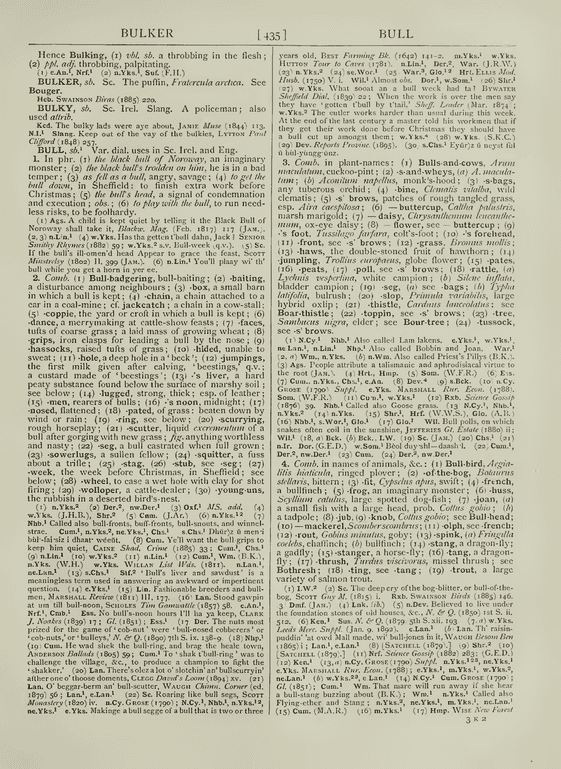

Source:GENERAL VIEW OF THE AGRICULTURE OF THE ORKNEY ISLANDS WITH OBSERVATIONS ON THE MEANS OF THEIR IMPROVEMENT DRAWN UP FOR THE CONSIDERATION OF THE BOARD OF AGRICULTURE BY JOHNS HIRREFF 1814
